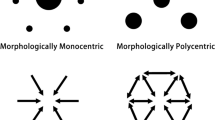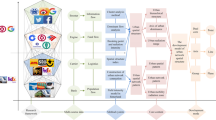Abstract
Polycentric urban development has become a prominent phenomenon in China since many cities advocate the strategy by revising spatial planning. Existing research mainly focuses on quantifying functionally polycentric degrees and inter-city differences based on rank-size analysis. Still, it seldom elaborates dynamic functional linkages at the intra-urban scale based on flow analysis. This study fills the gap by proposing a methodological framework to measure functional polycentricity using link strength, direction, and dynamics. Based on social network analysis of taxi trajectories, we reveal the spatial structure by link strength and temporal patterns of link direction and link dynamics. The case study in Changsha discloses that the city has a four-level polycentric system compared with the three-level one proposed in the master planning. Link direction result demonstrates a centrifugal pattern from Main Center towards the periphery, reflecting the mediation role of urban centers in the network. Link dynamics result indicates the single function of urban subcenters/clusters for residence or employment, reflecting insufficient public services. Thus, the results provide meaningful reflections on polycentric planning and policy-making.









Similar content being viewed by others
Data availability
Data available on request from the authors.
References
Aguilera A (2005) Growth in commuting distances in French Polycentric Metropolitan Areas: Paris, Lyon and Marseille. Urban Stud 42(9):1537–1547
Barton B (1978) The creation of centrality. Ann Assoc Am Geogr 68(1):34–44
Bentlage M, Müller C, Thierstein A (2021) Becoming more polycentric: public transport and location choices in the Munich Metropolitan Area. Urban Geogr 42(1):79–102
Borgatti SP, Halgin DS (2011) On Network Theory. Organ Sci 22(5):1168–1181
Burger M, Meijers E (2012) Form follows function? Linking morphological and functional polycentricity. Urban Stud 49(5):1127–1149
Burger MJ, Van Der Knaap B, Wall RS (2014) Polycentricity and the multiplexity of urban networks. Eur Plan Stud 22(4):816–840
Castells M (1996) The rise of the network society. Blackwell, Cambridge, MA
Cheng H, Shaw D (2018) Polycentric development practice in master planning: the case of China. Int Plan Stud 23(2):163–179
Commission of the European Communities (CEC) (1999) European Spatial Development Perspective: Towards Balanced and Sustainable Development of the Territory of the EU. Office for Official Publications of the European Communities, Luxembourg
Dadashpoor H, Afaghpoor A, Allan A (2017) A methodology to assess the spatial configuration of urban systems in Iran from an interaction perspective. GeoJournal 82(1):109–129
Davoudi S (2003) European briefing: polycentricity in European spatial planning: from an analytical tool to a normative agenda. Eur Plan Stud 11(8):979–999
De Goei B, Burger MJ, Van Oort FG et al (2010) Functional polycentrism and urban network development in the Greater South East, United Kingdom: evidence from commuting patterns, 1981–2001. Reg Stud 44(9):1149–1170
Derudder B, Liu XJ, Wang MS et al (2021) Measuring polycentric urban development: the importance of accurately determining the ‘balance’ between ‘centers.’ Cities 111:103009
Giuliano G, Redfearn C, Agarwal A et al (2012) Network accessibility and employment centres. Urban Stud 49(1):77–95
Gong L, Liu X, Wu L et al (2016) Inferring trip purposes and uncovering travel patterns from taxi trajectory data. Cartogr Geogr Inf Sci 43(2):103–114
Gong SH, Cartlidge J, Bai RB et al (2020) Extracting activity patterns from taxi trajectory data: a two-layer framework using spatio-temporal clustering, Bayesian probability and Monte Carlo simulation. Int J Geogr Inf Sci 34(6):1210–1234
Green N (2007) functional polycentricity: a formal definition in terms of social network analysis. Urban Stud 44(11):2077–2103
Hall PG, Pain K (eds) (2006) The polycentric metropolis: learning from mega-city regions in Europe. Routledge
Hall P (2009) Looking backward, looking forward: the city region of the mid-21st century. Reg Stud 43(6):803–817
Harrison J, Hoyler M (2014) Governing the new metropolis. Urban Stud 51(11):2249–2266
Hu S, Gao S, Wu L et al (2021) Urban function classification at road segment level using taxi trajectory data: a graph convolutional neural network approach. Comput Environ Urban Syst 87:101619
Jana M, Sar N (2016) Modeling of hotspot detection using cluster outlier analysis and Getis-Ord Gi* statistic of educational development in upper-primary level, India. Model Earth Syst Environ 2(2):1–10
Kloosterman RC, Lambregts B (2001) Clustering of economic activities in polycentric urban regions: the case of the randstad. Urban Stud 38(4):717–732
Kloosterman RC, Musterd S (2001) The polycentric urban region: towards a research agenda. Urban Stud 38(4):623–633
Li MY, Ye XY, Zhang SQ et al (2018) A framework of comparative urban trajectory analysis. Environ Plan B: Urban Anal City Sci 45(3):489–507
Li BZ, Cai ZL, Jiang LL et al (2019) Exploring urban taxi ridership and local associated factors using GPS data and geographically weighted regression. Cities 87:68–86
Li YF, Sun Q, Ji XL et al (2020) Defining the boundaries of urban built-up area based on taxi trajectories: a case study of Beijing. J Geovis Spat Anal 4(1):1–12
Li HB, Xu XC, Li X et al (2021) Characterizing the urban spatial structure using taxi trip big data and implications for urban planning. Front Earth Sci 15(1):70–80
Liu K (2018) Spatiotemporal analysis of human mobility in Manila metropolitan area with person-trip data. Urban Sci 2(1):3
Liu XJ, Wang MS (2016) How polycentric is urban China and why? A case study of 318 cities. Landsc Urban Plan 151:10–20
Liu Y, Wang FH, Xiao Y et al (2012) Urban land uses and traffic ‘source-sink areas’: evidence from GPS-enabled taxi data in Shanghai. Landsc Urban Plan 106(1):73–87
Liu K, Murayama Y, Ichinose T (2020) Using a new approach for revealing the spatiotemporal patterns of functional urban polycentricity: a case study in the Tokyo metropolitan area. Sustain Cities Soc 59:102176
Meijers E (2007) From central place to network model: theory and evidence of a paradigm change. Tijdschr Econ Soc Geogr 98(2):245–259
Meijers E (2008) Measuring polycentricity and its promises. Eur Plan Stud 16(9):1313–1323
Meijers EJ, Burger MJ (2010) Spatial structure and productivity in US metropolitan areas. Environ Plan A: Econ Space 42(6):1383–1402
Miller HJ, Goodchild MF (2015) Data-driven geography. GeoJournal 80(4):449–461
Morshed M, Chakraborty T, Mazumder T (2022) Measuring Dhaka’s urban transformation using nighttime light data. J Geovis Spat Anal 6(2):1–13
Niu N, Liu XP, Jin H et al (2017) Integrating multi-source big data to infer building functions. Int J Geogr Inf Sci 31(9):1871–1890
Nong Y, Zhou SH, Liu L et al (2017) Structural cities: delimiting retailing center boundaries and their hierarchical characteristics in urban China based on GPS-enabled taxi data. J Plan Educ Res 39(3):345–359
Opsahl T, Agneessens F, Skvoretz J (2010) Node centrality in weighted networks: generalizing degree and shortest paths. Soc Networks 32(3):245–251
Parr J (2004) The polycentric urban region: a closer inspection. Reg Stud 38(3):231–240
Preston RE (1971) The structure of central place systems. Econ Geogr 47(2):136–155
Sarkar S, Wu H, Levinson DM (2020) Measuring polycentricity via network flows, spatial interaction and percolation. Urban Stud 57(12):2402–2422
Scott J (1988) Trend Report Social Network Analysis. Sociology 22(1):109–127
Shi WZ, Zhang AS, Zhou XL et al (2018) Challenges and prospects of uncertainties in spatial big data analytics. Ann Assoc Am Geogr 108(6):1513–1520
Shu XF, Han HY, Huang C et al (2020) Defining functional polycentricity from a geographical perspective. Geogr Anal 52(2):169–189
Taylor PJ (2010) Specification of the world city network. Geogr Anal 33(2):181–194
Taylor PJ, Hoyler M, Verbruggen R (2010) External urban relational process: introducing central flow theory to complement central place theory. Urban Stud 47(13):2803–2818
Vasanen A (2012) Functional polycentricity: examining metropolitan spatial structure through the connectivity of urban sub-centres. Urban Stud 49(16):3627–3644
Wang TY, Yue WZ, Ye XY et al (2020) Re-evaluating polycentric urban structure: a functional linkage perspective. Cities 101:102672
Wang WK, Wang YP, Kintrea K (2020) The (re) making of polycentricity in China’s planning discourse: the case of Tianjin. Int J Urban Reg Res 44(5):857–875
Wei L, Luo Y, Wang M et al (2020) Multiscale identification of urban functional polycentricity for planning implications: an integrated approach using geo-big transport data and complex network modeling. Habitat Int 97:102134
Yao XC, Li GQ (2018) Big spatial vector data management: a review. Big Earth Data 2(1):108–129
Yao Y, Yatao Z, Qingfeng G et al (2019) Sensing multi-level urban functional structures by using time series taxi trajectory data. Geomatics Inf Sci Wuhan Univ 44(6):875–884 ((in Chinese))
Yu HS, Yang J, Li T et al (2022) Morphological and functional polycentric structure assessment of megacity: an integrated approach with spatial distribution and interaction. Sustain Cities Soc 80:103800
Yue WZ, Wang TY, Liu Y et al (2019) Mismatch of morphological and functional polycentricity in Chinese cities: an evidence from land development and functional linkage. Land Use Policy 88:104176
Zhang ZH, Zhang YS, He T et al (2022) Urban vitality and its influencing factors: comparative analysis based on taxi trajectory data. IEEE J Sel Top Appl Earth Obs Remote Sens 15:5102–5114
Zhao PX, Liu XT, Kwan MP et al (2020) Unveiling cabdrivers’ dining behavior patterns for site selection of ‘taxi canteen’ using taxi trajectory data. Transportmetrica A: Transport Sci 16(1):137–160
Zhen F, Qin X, Ye XY et al (2019) Analyzing urban development patterns based on the flow analysis method. Cities 86:178–197
Zhang JL, Luo Y (2017) Degree centrality, betweenness centrality, and closeness centrality in social network. In: Proceedings of the 2017 2nd International Conference on Modelling, Simulation and Applied Mathematics (MSAM2017), Atlantis Press, pp 300–303
Funding
This study was funded by the National Natural Science Foundation of China (grant number 41871169, 71974022, and 41871318) and the Support Scheme of Guangzhou for Leading Talents in Innovation and Entrepreneurship.
Author information
Authors and Affiliations
Corresponding author
Ethics declarations
Ethics Approval
The authors were compliant with the ethical standards.
Consent to Participate
All authors agreed with the content and submission.
Conflict of Interest
The authors declare no competing interests.
Additional information
Publisher's Note
Springer Nature remains neutral with regard to jurisdictional claims in published maps and institutional affiliations.
Rights and permissions
Springer Nature or its licensor (e.g. a society or other partner) holds exclusive rights to this article under a publishing agreement with the author(s) or other rightsholder(s); author self-archiving of the accepted manuscript version of this article is solely governed by the terms of such publishing agreement and applicable law.
About this article
Cite this article
Yue, W., Wei, J., Liu, Y. et al. Investigating Intra-urban Functional Polycentricity from a Linkage Perspective: the Case of Changsha, China. J geovis spat anal 7, 1 (2023). https://doi.org/10.1007/s41651-023-00132-6
Accepted:
Published:
DOI: https://doi.org/10.1007/s41651-023-00132-6




